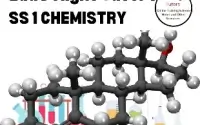Mid-Term Assessment – Chemistry SS 1 Chemistry SS 1 First Term Lesson Notes
Mid-Term Assessment – Chemistry SS 1
Assessment Components:
- Part A: Objective Questions (20 Multiple Choice Fill-in-the-Blank Questions)
- Part B: Theory Questions (20 Short Answer Questions)
- Part C: True or False Statements (20 Questions)
- Part D: Fill-in-the-Blank Questions (20 Questions without Options)
Part A: Objective Questions (Fill-in-the-Blank with Options)
- The __________ state has particles that vibrate in fixed positions.
a) liquid
b) solid
c) gas
d) plasma - __________ is the process by which a solid turns directly into a gas.
a) Freezing
b) Condensation
c) Evaporation
d) Sublimation - The atomic number represents the number of __________ in an atom.
a) neutrons
b) electrons
c) protons
d) ions - In chemical reactions, matter is neither created nor destroyed. This is the law of __________.
a) conservation of energy
b) multiple proportions
c) constant composition
d) conservation of matter - A state of matter with a fixed volume but no fixed shape is __________.
a) solid
b) liquid
c) gas
d) plasma - __________ bonds involve the transfer of electrons from one atom to another.
a) Covalent
b) Ionic
c) Metallic
d) Hydrogen - In the liquid state, particles __________.
a) move freely and rapidly
b) slide past each other
c) vibrate in fixed positions
d) do not move - According to Dalton’s atomic theory, atoms of the same element are __________.
a) identical
b) different
c) unstable
d) always bonded - The relative atomic mass is measured relative to the isotope __________.
a) C-12
b) O-16
c) C-14
d) H-1 - The __________ states that a chemical compound always contains its component elements in fixed ratios.
a) law of conservation
b) law of constant composition
c) law of motion
d) law of gravity - The particles in a gas move __________.
a) slowly and vibrate in place
b) close to each other
c) far apart and quickly
d) very slowly - The kinetic theory of matter states that particles are in constant __________.
a) rest
b) motion
c) collision
d) growth - The empirical formula represents the __________ ratio of elements in a compound.
a) actual
b) molecular
c) simplest
d) chemical - __________ refers to the sharing of electrons between atoms.
a) Ionic bond
b) Covalent bond
c) Metallic bond
d) Hydrogen bond - Elements in the same __________ have similar chemical properties.
a) row
b) period
c) group
d) formula - The number of electrons in the first shell of an atom is __________.
a) 4
b) 2
c) 6
d) 8 - Water in the __________ state has no definite shape or volume.
a) liquid
b) solid
c) gas
d) plasma - The atomic mass of an atom depends on the number of __________.
a) electrons
b) protons
c) neutrons
d) protons and neutrons - The formula for a compound with two hydrogen atoms and one oxygen atom is __________.
a) HO
b) H2O
c) OH2
d) O2H - __________ is used to represent elements in chemical equations.
a) Atomic mass
b) Symbols
c) Formulae
d) Bonds
Part B: Theory Questions (Short Answer)
- Define kinetic theory.
- What is an ionic bond?
- Describe a covalent bond.
- Explain the law of conservation of mass.
- How do particles in gases differ from those in liquids?
- State Dalton’s atomic theory.
- What is relative atomic mass?
- Define empirical formula.
- List three characteristics of solids.
- What is sublimation?
- Describe the process of condensation.
- Name the three states of matter.
- Explain the structure of an atom.
- What is isotropy?
- Why can gases be compressed?
- Differentiate between atomic number and mass number.
- What is the importance of the periodic table?
- How do protons differ from neutrons?
- State the law of constant composition.
- What is a molecule?
Part C: True or False Statements
- Solids have a fixed shape and volume. (True/False)
- The atomic number is equal to the number of electrons in a neutral atom. (True/False)
- A covalent bond involves the sharing of electrons. (True/False)
- The first 20 elements in the periodic table are all gases. (True/False)
- Dalton’s atomic theory suggests that atoms cannot be created or destroyed. (True/False)
- Atoms of the same element can have different atomic numbers. (True/False)
- Water is a compound. (True/False)
- The particles in a gas are tightly packed. (True/False)
- Protons are positively charged particles. (True/False)
- Empirical formulas show the actual number of atoms in a molecule. (True/False)
- Neutrons have no charge. (True/False)
- Chemical symbols are used to represent compounds. (True/False)
- Solids can flow like liquids. (True/False)
- Elements are composed of only one type of atom. (True/False)
- The kinetic theory applies only to gases. (True/False)
- The periodic table organizes elements by atomic mass. (True/False)
- Atoms are the basic units of matter. (True/False)
- In a chemical equation, reactants are on the left side. (True/False)
- Chemical reactions conserve mass. (True/False)
- Oxygen is a metal. (True/False)
Part D: Fill-in-the-Blank Questions (Without Options)
- The smallest particle of an element that retains its properties is called a(n) __________.
- __________ is a force that holds atoms together in a molecule.
- When a gas changes into a liquid, it is called __________.
- The first shell of an atom can hold a maximum of __________ electrons.
- __________ is the energy required to change a liquid to a gas.
- The elements in the same group on the periodic table have similar __________.
- The atomic number of an element is equal to the number of __________ in an atom.
- __________ is the process where a solid changes directly into a gas without becoming liquid.
- __________ represents the chemical symbol for hydrogen.
- Matter can exist in three main states: solid, __________, and gas.
- An ion with a positive charge is called a __________.
- __________ is the measure of the amount of matter in an object.
- An atom consists of protons, neutrons, and __________.
- __________ bonding occurs when electrons are transferred between atoms.
- The chemical formula for sodium chloride is __________.
- The atomic mass of an element depends on the number of protons and __________.
- Elements arranged in the periodic table are grouped by __________ properties.
- In a chemical reaction, substances that start the reaction are called __________.
- __________ is a compound formed by the combination of two hydrogen atoms and one oxygen atom.
- __________ states that matter cannot be created or destroyed during a chemical reaction.
This assessment format covers essential concepts in Chemistry for SS 1 students, promoting comprehensive understanding through diverse question types.
Related
Related posts:
- Exploring Chemistry: Meaning, Careers & Real-Life Applications – SS 1 Lesson Chemistry SS 1 First Term Lesson Notes Week 1
- Understanding the Particulate Nature of Matter and Atomic Structure Chemistry SS 1 First Term Lesson Notes Week 4
- Understanding Symbols, Formulae, and the Law of Conservation in Chemistry SS 1 First Term Lesson Notes Week 5
- Understanding Naming Systems in Chemistry: Conventional vs. IUPAC Chemistry SS 1 First Term Lesson Notes Week 9
- States of matter and kinetic theory Chemistry SS 1 First Term Lesson Notes Week 10
Related Posts

Health Education Examination of the Topics Covered in the First Term SS 1

CHEMICAL FORMULAE AND EQUATIONS

Understanding the Basics of Building Construction SS 1 First Term Lesson Notes Week 1
About The Author
Edu Delight Tutors
Am a dedicated educator with a passion for learning and a keen interest in technology. I believe that technology can revolutionize education and am committed to creating an online hub of knowledge, inspiration, and growth for both educators and students. Welcome to Edu Delight Tutors, where learning knows no boundaries.